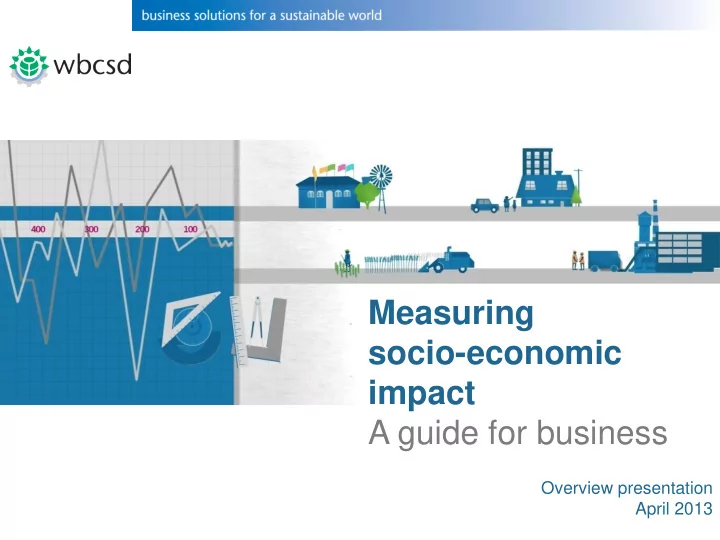

Measuring socio-economic impact A guide for business Overview presentation April 2013
Context Companies: increasingly interested in measuring socio- economic impact as part of: - Maintaining their license to operate - Improving the enabling environment - Strengthening their value chains - Fueling product and service innovation Many tools available, however: - Diversity in tools - Based on different assumptions - Offering different functionality - Focusing on different types of impact - Suiting different purposes
About the guide Measuring socio-economic impact: A guide for business Main aim: help companies navigate the complex landscape of socio-economic impact measurement. The The The The business road essentials tools case ahead Outlines Introduces the Suggests areas Profiles a business terminology of focus to selection of 10 motivations for and basic accelerate publicly measuring socio- theory used in business efforts available tools economic impact this space for a to measure and tailored for business manage socio- business audience economic impact needs
Part 1: The business case
Part 2: The essentials How do business activities translate into socio- economic impacts? (“results chain”, “route to impact”) Measurement can happen anywhere with specific metrics along the results chain Socio- economic impact is the “end goal” in terms of change in assets, capabilities, opportunities, and Impact standards of living – positive or negative, intended or unintended, temporary or sustainable over time Measuring “impact”, in the technical sense of the Outcome word, is challenging to do (decreasing influence along the results chain – time lags, contribution vs. attribution, lack of baseline data) Output Prioritization needed; judicious use of proxies can Activity be key (ex. number of units of products sold, the Input output, as good proxy for reduction in the incidence of a disease)
Part 3: 10 tools selected and analyzed along several dimensions Strategic fit (link to the business case) Applicable level(s) of analysis (site value chain, operations at national level, etc.) Guidance included (setting scope, selecting indicators, interpreting results) Metrics (input, activity, output, outcome, impact) Data requirements (internal company data, external data collection) Key audiences (company managers, civil society, governments, etc.) Level of effort to implement Developer services Practical examples of their application on the ground
The 10 tools profiled
Tools analysis overview
Part 4: Road ahead Evolving landscape of tools – guide intended to be a living document , updated and improved as existing tools are updated and new ones emerge Advance the practice by: - Integrating measurement into business performance management and reporting, and driver of action - Using measurement to drive more effective collaboration between business, government, and civil society – data drives better understanding of roles and high-potential impacts
Access the guide and supporting materials www.wbcsd.org/impact.aspx
Recommend
More recommend